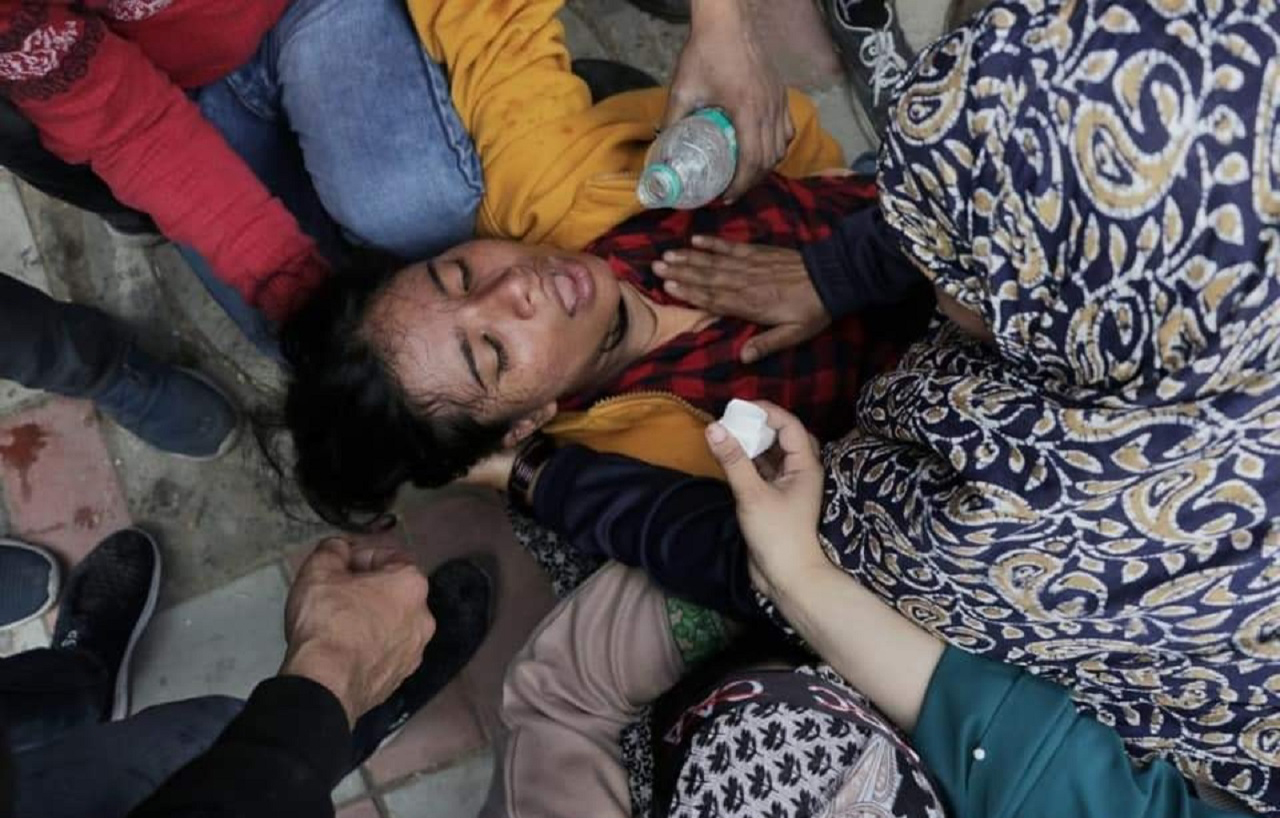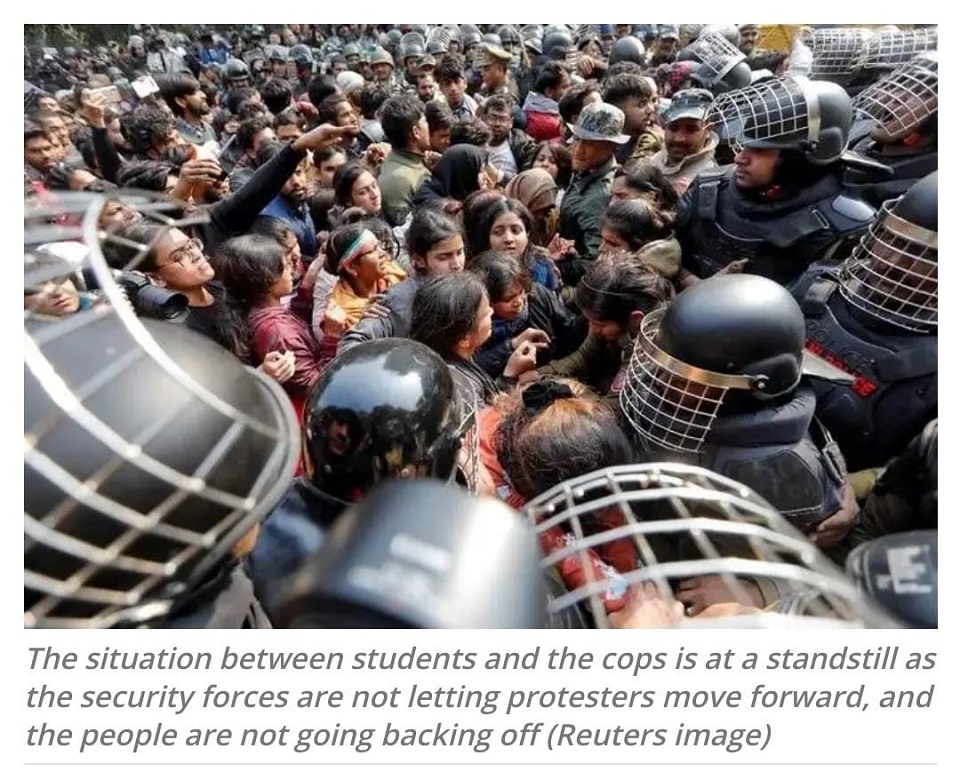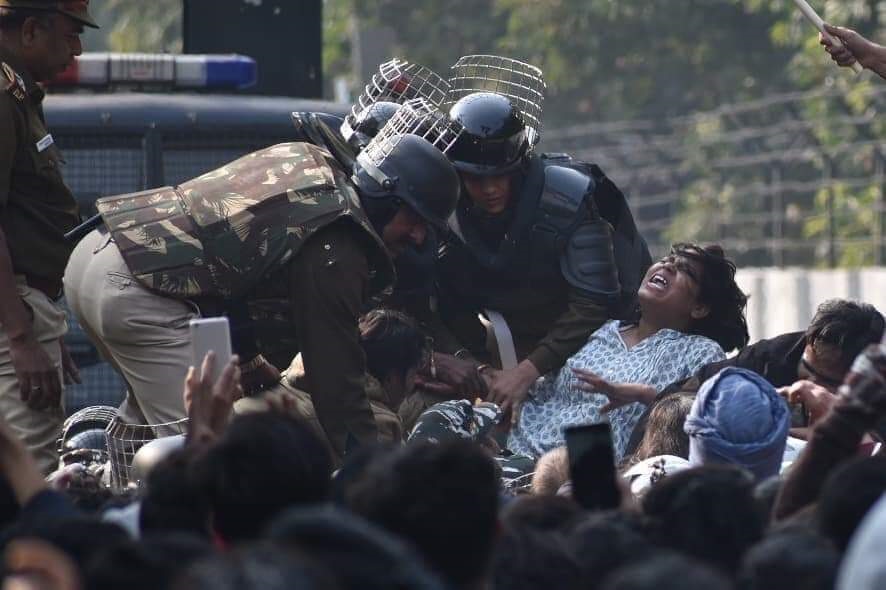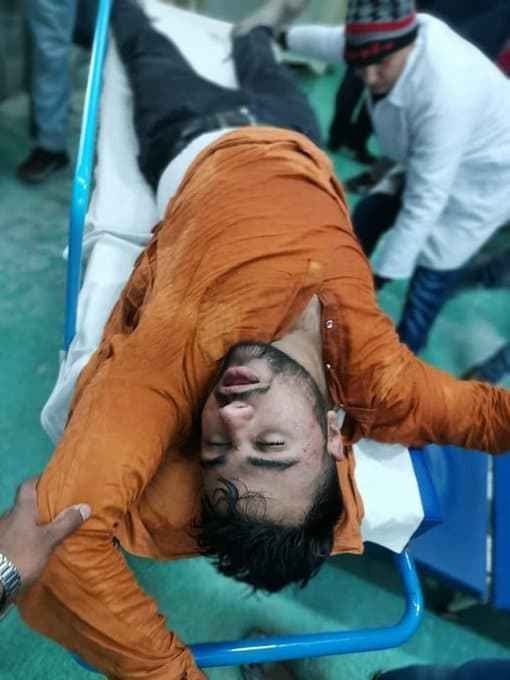The brutality and terror unleashed by the security personnel on Jamia students in the name of “crowd-control,” clearly betray the rage that the police force has towards the protesters against the current regime. One can even argue, this rage is essentially majoritarian, imbued with Hindu nationalist philosophy at the core and showing fascistic tendencies, writes Sumanta Poddar.
“El violador eras tú,
El violadorerestú.
Son lospacos,
losjueces,
el Estado,
el presidente.
El Estado opresores un macho violador
El Estado opresores un macho violador
El Estado opresores un macho violador
El Estado opresores un macho violador
El violador eras tú.
El violadorerestú.”
(English Translation given below)
The rapist was you
The rapist is you.
It’s the cops,
The Judges,
The State,
The President.
The oppressive state is a rapist man.
The oppressive state is a rapist man.
The oppressive state is a rapist man.
The oppressive state is a rapist man.
The rapist was you
The rapist is you.
Quoted above is a part of the Chilean feminist performance piece protesting against violence against women. It was created by a feminist collective from Valparaíso named Las Tesis, and performed on 25th November 2019. Since then, it has permeated the spaces of protests all over the world. The striking nature of the performance and its boldness made it so appealing, that it created a deep and pervasive effect in the protests where protesters stood firmly against their respective state’s oppression.
But what is its connection with the Jamia protests that happened yesterday or that has been happening since the CAA-2019 was passed in the Parliament us? Does it really make any connection? Yes, it does. Let us see how.
On 10 February, 2020 a protest march towards Parliament House at New Delhi was organized. It was named ‘Sansad Gherao’. The protesters, including the Jamia alumni, were led by the Jamia Coordination Committee (JCC), and were walking against the Citizenship Amendment Act, 2019 (CAA) and the impending National Register of Citizens (NRC). There was heavy deployment of security personnel, many donning riot gear, in and around the University when the protest march began from Jamia’s gate 7 at around 1.30 pm. The protesters raised slogans like “Hum Kagaz Nahi Dikhayenge” (we will not furnish our papers), “Jab nahi darey hum goron se, toh kyun darey hum auronsey” (When we did not fear the British, then why should we fear others”), and “Aainke dum pe march karenge” (We will march with power from the Constitution). A large number of women protesters were part of this march. Men formed a human chain on either sides of the road, as women walked ahead.
“It has been two months that we are protesting. No one from the Government has come to talk to us, so we want to go to talk to them”, said Zeba Anhad, a protester.
“It has been two months that we are protesting. No one from the Government has come to talk to us, so we want to go to talk to them”, said Zeba Anhad, a protester. The police set up several barricades starting from two kilometers of the University up to the approaches of Parliament House. When the march reached Holy Family Hospital at Okhla, police stopped the protesters, and a scuffle began. The protesters climbed the barricade to continue their protest march towards Parliament House. The real scuffle started at about 4.30pm when the DCP, Delhi Police himself climbed the barricade to remove the protesters from there and the entire police force started to try to push back them. This method of pushing back the protesters was allegedly done with so much brutality that a number of student-protesters forming the front-line of the march had to be admitted to the hospital, in poor condition. The protesters continued their protests till the evening, whereby the police forces constantly urged them to return to gate 7 of the University, from where the march had begun. By then,it was found that more than ten students of Jamia who participated in the anti-CAA protest march towards Parliament House, had to be admitted to Jamia Health Centre for injuries in their private parts.
From the reports obtained from the resident doctors at the Health Centre, it was found that those female students having been hit on their private parts, the injuries being of blunt nature, had to be shifted to Al-Shifa hospital.
At the Health Centre, a female student, who was being treated for injuries, complained that a woman cop removed her burqa and hit her in her private parts with a lathi and boots.
From the reports obtained from the resident doctors at the Health Centre, it was found that those female students having been hit on their private parts, the injuries being of blunt nature, had to be shifted to Al-Shifa hospital. Some students also suffered internal injuries as they were hit on chest with lathis. Two male students were also allegedly hit on their private parts. At the Health Centre, a female student, who was being treated for injuries, complained that a woman cop removed her burqa and hit her in her private parts with a lathi and boots. Another student said that the cops were beating them in areas below the belt, so that the camera could not capture it. According to her, the police were pushing them so hard that they got stuck in a stampede four or five times. A male student, admitted at the emergency, complained that the police had kicked him on his private parts. As the police were beating the women, he had tried to rescue them and was hit at the chest with lathi, he said. Another male student admitted at the Jamia Health Centre, complained that he was hit so badly that he fainted twice. According to him, he, too, was hit at his private parts. Till evening on 10 February, about two hundred students were stuck at the barricade.
Some sources claim that Delhi Police sprayed some substance in air at the protest site. A doctor at the Al-Shifa hospital confirmed that the Delhi Police had used a toxic chemical spray against the protesters, which lead thirty of them to be hospitalized after the exposure. They complained of dizziness and nausea. Some also fainted. Dr. Azeem at the Al-Shifa hospital, who treated the victims, in the aftermath said that their symptoms were not consistent with those seen from exposure to pepper spray. The victims were panicking and complaining of suffocation, stomach ache and pains in their abdomen and chest. Among them, one was really finding it difficult to breathe even after several medications, so he was transferred to the ICU.
Some unconfirmed social media sources claim that the spray may have contained CS gas, which, unlike the conventional tear gas, is used by the police forces for crowd-control. The CS gas is called a first category TRPA1-activating agent, the chemical name of which is 2-chloro benzal malononitrile. This is a chlorine-containing compound that blows into the air as fine particulate. They chemically react with bio-molecules and proteins on the human body which can cause a severe burning sensation. This is commonly used by US law enforcement agencies, as well as by the British Police. The CS was used in 2011 in Tahrir Square protests in Egypt by the military JUNTA regime for riot-control. The supply of the gas came from the US company Combined Systems Inc. (CSI). In the aftermath of using the gas on the protesters, some of them are reported to be dead.
This same CSI had also supplied the CS gas to the Israel government for using it upon the Palestinian protesters. The same company supplied the CS gas to the autocratic regime of Jin El Abidin Ben Aliin Tunisia. An interesting finding was observed in US Military trial of the CS gas, whereby it affected more the people who actively moved in its atmosphere after its administration, rather than those who remained passive before it. Actually, CS is solid at room temperatures and thus cannot be described as a “gas”. When used for riot control purposes, it is dispersed as a micro-particulate cloud produced by a pyrotechnic device. In order to deploy CS as a spray, a non-aqueous solvent needs to be used – methyl isobutyl ketone (MIBK) in the case of the British police sprays. MIBK is an industrial de-greasing agent, which will remove lipid from the skin causing reddening, scaling, blistering and peeling as well as irritation of the eyes and respiratory tract. In the chemical industry, the use of skin and eye protection is advised when handling MIBK. Yet, paradoxically, the British police are trained to spray this chemical directly into a person’s face from a“squirt can” from which a stream of liquid is released. In one or two studies, the CS gas was found to have clastogenic effect, i.e. it can cause gene mutation resulting in mutagenesis and carcinogenesis. But still, its use on yesterday’s Jamia-protests is not yet fully confirmed. Only some of the Health professionals and the doctors say that some unknown and unidentified chemical substance containing chlorine in low concentration may have been used.
Previously, on 15 December, 2019 the police entered the Jamia Milia Islamia University campus and while unleashing a brutal lathi-charge, they had also used tear gas canisters inside the campus. This act reportedly violated the United Nation’s guidance on the use of chemical irritants. The latest edition of the UNHR Guidance on Less-Lethal Weapons in Law Enforcement states that the irritant projectiles should not be fired directly at a person, especially the head and the face, since it may cause death or serious injury from impact trauma. However, the protesters were allegedly injured due to direct contact with tear gas shells fired by the police on that day inside the campus.
The brutality of police forces and security personnel was allegedly so high that it inculcated a permanent scar and trauma within the minds of the student-protesters, especially the female students, the Muslim students.The brutality and terror unleashed by the security personnel in the name of “crowd-control,” clearly betray the rage that the police force has towards the protesters against the current regime. One can even argue, this rage is essentially majoritarian, imbued with Hindu nationalist philosophy at the core and showing fascistic tendencies.
The brutality of police forces and security personnel was allegedly so high that it inculcated a permanent scar and trauma within the minds of the student-protesters, especially the female students, the Muslim students.The brutality and terror unleashed by the security personnel in the name of “crowd-control,” clearly betray the rage that the police force has towards the protesters against the current regime. One can even argue, this rage is essentially majoritarian, imbued with Hindu nationalist philosophy at the core and showing fascistic tendencies. The media reports covering the incidents miss the crude and disturbing fact based on statistics from the Central Government Resources that the entire law enforcement agency and regiment of military and para-military forces of the Indian state,has been gradually made devoid of the Muslim population of this country. In the 1950s, the percentage of Muslim officers in the IPS – the elite leadership body of national policing – was already lower than 5 per cent, less than half the proportion of Muslims in Indian society according to 1951 census. While the share of Muslims in the population subsequently rose, reaching 14.25 per cent in 2011, the population of Muslims in the IPS dwindled, falling beneath the 3 per cent mark in 2016, and even as low as 2.5 per cent of the whole service if Jammu and Kashmir is excluded from the calculation. Never had the gap between the share of Muslims in the population and their share in the IPS been so wide.
Thus the police brutality, especially against the student-protesters of Jamia Milia Islamia University, contains a clear notion of Hindu-Fascistic motive towards Muslims, as the higher echelons of police force are being gradually captured by the Bramhinical entities. It will not be an exaggeration to argue that such a political impulse has existed almost right from the independence of this country. However, factually, the JMIU does not only house Muslim students. But the Hindu-Fascistic narrative, in synthesizing Islamophobia all through the Indian society, is clearly manifested from the type of force applied to control the protesters, and every public statement made by the police authorities regarding the “violent nature” of the protesters, and thus justifying their own brutality.
Thus, it is very clear at this point, how the popular “The Rapist is you” song finds a place in our protests also. In fact, it’s a war-like situation that the Indian State is up to. And, in this war, the most suffered are the women, the children and other marginal people.
[This article has been written using various inputs taken from Media reports, websites, Social media posts, and Ministry of Home Affairs resources. A sincere effort has been made to remain closer to the facts at the ground and omitting the unconfirmed data as far as possible. All images used in the article sourced from Facebook posts of various activists.]
The author, Sumanta Poddar is a political activist.




